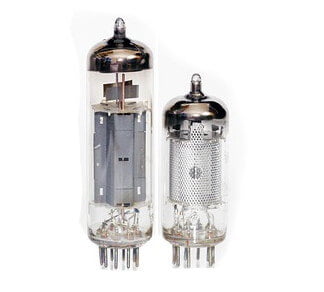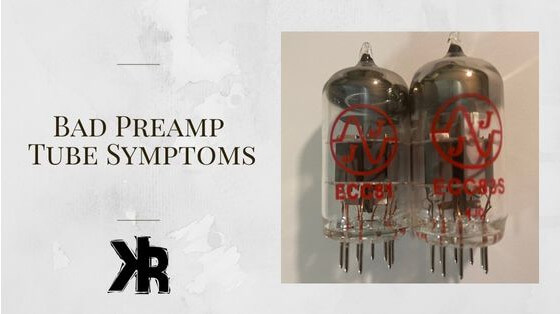Table of Contents
When a preamp tube begins to fail, it can be hard to know how to troubleshoot the fault. If your amp has more than one, this makes it even more difficult.
A bad preamp tube will become very noisy and produce hiss, crackle, and pop sounds, or create volume drops or loss.
In some rare conditions, the tube can also lose its vacuum and fail completely. Bad preamp tube symptoms can lead you to the faulty one if you know what to look for. In this Killer Rig article, we will explore some of them and what you can do to fix any issues.
Can a Preamp Tube Go Bad?
Preamp tubes can go bad at any time and for any reason. There is normally no way to determine how long they will last. Sometimes the heater inside can fail and will no longer glow. This will prevent it from working completely.
In other circumstances, a failure inside can cause volume loss or distortion issues. Most of which were not there before. And even though preamp tubes can last a very long time, this is not the case with each one.
Bad Preamp Tube Symptoms
There are a few things that are more common when preamp tubes begins to fail. You might experience things like:
- Crackling
- Popping sounds
- Volume loss
- Squealing
- Hum or feedback
If sounds begin to appear that were never there before, it’s possible that you have a failing preamp tube. If your amp has more than one, it can be difficult to determine which is the culprit.
Preamp Tubes Not Glowing
One common issue with preamp tubes is that the heater inside might stop working. When this happens, it will no longer glow, and be impossible to use.
This is an orange color in the middle of the tube. You can normally see it by looking inside at the top or bottom of the tube.
Sometimes it can be difficult to see, depending on the design. But if the heater stops working, the tube will not work.
Most people inspect them to see if they are glowing, and this is a good start, but not the only thing that can cause issues. If you do see the glow, this doesn’t necessarily mean the preamp tube is good or working.
Bad Preamp Tubes and Volume Loss
One of the more common problems with a bad preamp tube is volume loss. This can be caused by several issues that develop inside.
But are normally catastrophic failures. Depending on your amplifier, this could be evident in one single channel. Maybe it has no volume, while the others are fine.
It’s also possible to have volume loss in all channels. Or one that is significantly quieter than the others. This can be a sign that one of the preamp tubes needs to be replaced.
Then there are volume fluctuations. When a preamp tube goes bad, the volume could be fine. Until it begins to warm up and then produce fluctuations. Sometimes it is a while after the tube has been used before it presents itself.
Weaker signals are also a sign of a bad preamp tube. It can be something that is always present. Or, like fluctuations, only happens after some use but can take an amp down to half volume.

Bad Preamp Tubes and Distortion
If you’re noticing distortion in your audio that wasn’t there before, you may have a bad preamp tube. This distortion can be in the form of fuzz, hiss, or static.
It’s important to note that this distortion might also be caused by other issues in your amp. But it’s best to start with the preamp tubes.
What does a Bad preamp Tube Look Like?
There are only a few things that could alert you to a bad preamp tube simply by looking at it.
- Failed heater
- Vacuum Loss
- Cracked glass
When it comes to the failed heater, this one is pretty straightforward, if it isn’t glowing, the heater is bad. But when it comes to loss of vacuum or a cracked glass envelope, these can also be very clear.
Inside preamp tubes, you will find a shiny gray material at the top. This is called getter. This material is used to confirm that the tube is sealed, and the vacuum inside is intact.
When a tube begins to leak, or crack, this getter material will turn white and become flaky dust. If you notice this in any preamp tube, it has failed and can no longer be used.
Phase Inverter Tube Symptoms
A phase inverter is also a preamp tube, depending on the amplifier design. This means it will also exhibit the same types of failure signs as an audio circuit.
The difference with a phase inverter is that it is normally after the master volume control in an amp. As a result, some people mistakenly assume the power tubes are faulty. They hear noises that do not disappear when the volume is turned right down on the amp.
A failed phase inverter will create a complete or partial loss of signal of the entire amplifier. It is best to try the phase inverter tube before any others when this seems like the culprit.
How To Troubleshoot a Bad Preamp Tube
The best way to troubleshoot a bad preamp tube is by replacing it with a new one. This might seem like an obvious solution. But if you’re not sure which one is causing the problem, it can be difficult to know which one to replace.
Have a multichannel amp? Start by replacing the tubes in the channel that is experiencing issues. If this does not fix it, then replace the ones in the next channel. Continue doing this until you find the tube that is causing the issue.
Most manufacturers provide a block diagram of amplifiers. This is to help you understand the preamp tube positions in each circuit. This can be very helpful when attempting swaps.
It is also possible to use a tester to troubleshoot a bad preamp tube. This will tell you if they are good or bad, and can be helpful if you’re not sure which one is causing the issue.
Replacing a Preamp Tube
The most important thing to remember when replacing a tube is that there is a potential for high voltage. Before you proceed with a tube change, remove power from the amplifier and let it sit for 10 to 15 minutes.
Then, remove any shields or clamps. And in a small circular motion, rotate the tube while lightly pulling it upwards. This will release the pins from the holder. Installation is simply the reverse.
Conclusion
If you run a tube amp, it is always a good idea to have a spare on hand. A bad preamp tube can happen quickly, without warning, and at the worst of times. So keep one handy and learn how to change them so that you can quickly find and replace bad ones.
FAQs
Can bad preamp tubes cause volume loss?
Yes, a bad preamp tube can cause volume loss in an amplifier. This is usually due to the fact that it is not passing the signal correctly or has failed internally.
How do I know if my preamp tube is bad?
If the tube fails, the most apparent symptom is a complete loss of volume. If there is still volume, then it will develop noises that were not there before. These are some of the more common ways to know you have a bad preamp tube.
But things like missing frequencies can also alert you to an issue with your tubes. This can be something like a loss of treble, where the sound becomes much warmer when it wasn’t before.

